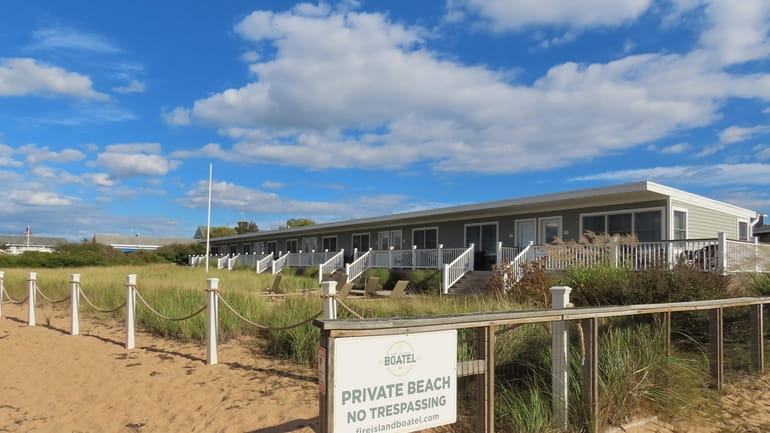Fire Island hotel expansion at Boatel in Kismet moves to Islip zoning board

Owners of the 1950s-era Boatel in Kismet, pictured Sept. 28, want to increase the bayfront hotel's height, but some neighbors object to the potential expansion in the quiet Fire Island community. Credit: Newsday/Mark Harrington
An Islip Town zoning board on Tuesday will consider the next step in a developer’s plan to add a second floor to a 1950s-era hotel in Kismet, amid greater scrutiny of wastewater management near the Great South Bay and a failed court challenge by a neighbor who fears a “towering eyesore.”
The Fire Island Boatel, a single-story hotel facing the bay, sits at the north end of East Lighthouse Walk in Kismet. Two years ago, the hotel’s new owners introduced a plan to add a second story onto the 165-foot-long flat structure, including a gable roof.
In initially approving the plan, the Islip Town Board in 2021 granted a zoning change from a residential code to one that suits a commercial hotel operation. Formal building plans have yet to be submitted, hotel co-owner Dwayne Diesu said.
Tuesday’s meeting will consider building setbacks from the public walk.
Diesu said the plan will give guests more space: a second-story bedroom with a balcony. A gable roof will raise the point of the building from about 12 feet to around 28 feet. He noted many nearby homes are just as high or higher.
Diesu added that he and his partners are “proud members of the Kismet community and only want what’s best for fellow residents.”
But some neighbors in the tight-knit community worry the development would alter the tiny hamlet’s character, obstruct bay views and increase waste, sewage and foot traffic.
“This is the first thing you see when you come into Kismet,” said Gary Leone, who recently finished construction on a home next door to the Boatel.
Opponents are calling the proposed structure “The Great Wall of Kismet.”
Tim Mooney, owner of Fire Island Ferries and a nearby homeowner whose bay view won’t be disturbed, approves of the plan.
“I’m one who believes a rising tide lifts all boats,” said Mooney, whose daughter worked on the Boatel’s interior designs.
Kismet homeowner Don Ahearn last January sued the developer, Lighthouse Shores, and the Islip Town Board in State Supreme Court, challenging the town’s approval and the proposal. In an interview, he said more than a dozen residents helped fund his lawsuit, though he was the only named plaintiff.
Ahearn’s chief concern is the building’s proposed height, which would block some neighbors’ views of the bay from their upper floors.
But State Supreme Court Justice David Reilly dismissed his case this month, finding Ahearn, at 293 feet from the Boatel, didn’t prove a “direct harm that is different from the public at large” while his other claims amounted only to “possible future inconveniences.”
Ahearn said he’s considering an appeal.
But complaints about the size and additional traffic are only part of challenges the plan may face. The facility maintains a 1950s-era septic tank, one Diesu said was cleaned out and re-piped two years ago and currently is in compliance with wastewater requirements.
Suffolk County has instituted new, stringent wastewater standards, and the state said the work could require tidal wetlands permits, among others.
“It’s really important to make sure a project like this does not add to nitrogen pollution in the bay or overtax the ability of the barrier island to sustain itself,” said Suzy Goldhirsch, president of the Fire Island Association, which represents the interests of residents and businesses and hasn’t taken a position on the Boatel upgrade.
Diesu said the work will comply with all requirements.
Locals said they’ll be watching.
An Islip Town zoning board on Tuesday will consider the next step in a developer’s plan to add a second floor to a 1950s-era hotel in Kismet, amid greater scrutiny of wastewater management near the Great South Bay and a failed court challenge by a neighbor who fears a “towering eyesore.”
The Fire Island Boatel, a single-story hotel facing the bay, sits at the north end of East Lighthouse Walk in Kismet. Two years ago, the hotel’s new owners introduced a plan to add a second story onto the 165-foot-long flat structure, including a gable roof.
In initially approving the plan, the Islip Town Board in 2021 granted a zoning change from a residential code to one that suits a commercial hotel operation. Formal building plans have yet to be submitted, hotel co-owner Dwayne Diesu said.
Tuesday’s meeting will consider building setbacks from the public walk.
Raising the Roof in Kismet
- A local developer wants to raise the roof on Fire Island's Boatel but some locals object.
- A judge recently dismissed a challenge to the plan.
- The work could require tidal wetlands permits.
Diesu said the plan will give guests more space: a second-story bedroom with a balcony. A gable roof will raise the point of the building from about 12 feet to around 28 feet. He noted many nearby homes are just as high or higher.
Diesu added that he and his partners are “proud members of the Kismet community and only want what’s best for fellow residents.”
But some neighbors in the tight-knit community worry the development would alter the tiny hamlet’s character, obstruct bay views and increase waste, sewage and foot traffic.
“This is the first thing you see when you come into Kismet,” said Gary Leone, who recently finished construction on a home next door to the Boatel.
Opponents are calling the proposed structure “The Great Wall of Kismet.”
Tim Mooney, owner of Fire Island Ferries and a nearby homeowner whose bay view won’t be disturbed, approves of the plan.
“I’m one who believes a rising tide lifts all boats,” said Mooney, whose daughter worked on the Boatel’s interior designs.
Kismet homeowner Don Ahearn last January sued the developer, Lighthouse Shores, and the Islip Town Board in State Supreme Court, challenging the town’s approval and the proposal. In an interview, he said more than a dozen residents helped fund his lawsuit, though he was the only named plaintiff.
Ahearn’s chief concern is the building’s proposed height, which would block some neighbors’ views of the bay from their upper floors.
But State Supreme Court Justice David Reilly dismissed his case this month, finding Ahearn, at 293 feet from the Boatel, didn’t prove a “direct harm that is different from the public at large” while his other claims amounted only to “possible future inconveniences.”
Ahearn said he’s considering an appeal.
But complaints about the size and additional traffic are only part of challenges the plan may face. The facility maintains a 1950s-era septic tank, one Diesu said was cleaned out and re-piped two years ago and currently is in compliance with wastewater requirements.
Suffolk County has instituted new, stringent wastewater standards, and the state said the work could require tidal wetlands permits, among others.
“It’s really important to make sure a project like this does not add to nitrogen pollution in the bay or overtax the ability of the barrier island to sustain itself,” said Suzy Goldhirsch, president of the Fire Island Association, which represents the interests of residents and businesses and hasn’t taken a position on the Boatel upgrade.
Diesu said the work will comply with all requirements.
Locals said they’ll be watching.

